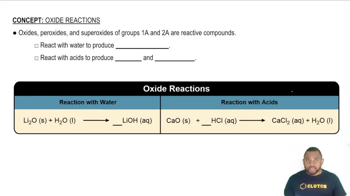Here are the essential concepts you must grasp in order to answer the question correctly.
Acidic Oxides
Acidic oxides are oxides that react with water to form acids or with bases to form salts. They are typically formed from nonmetals or metalloids and exhibit higher electronegativity. Examples include sulfur trioxide (SO3) and dichlorine heptoxide (Cl2O7), which are known for their strong acidic properties.
Recommended video:
Basic Oxides
Basic oxides are oxides that react with acids to form salts and water. They are usually derived from metals and have lower electronegativity. Barium oxide (BaO) and tin(IV) oxide (SnO2) are examples of basic oxides, with BaO being a strong base due to its alkaline earth metal nature.
Recommended video:
Trends in Acid-Base Character
The acid-base character of oxides generally increases with the nonmetallic character of the element. As you move from left to right across the periodic table, oxides become more acidic, while moving down a group typically leads to more basic oxides. This trend helps in predicting the acidic character of the given oxides based on their elemental composition.
Recommended video:
Metallic Character Trends
 Verified step by step guidance
Verified step by step guidance

